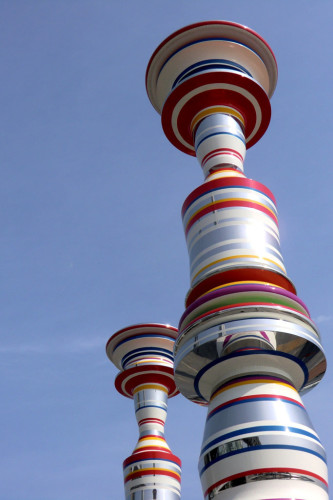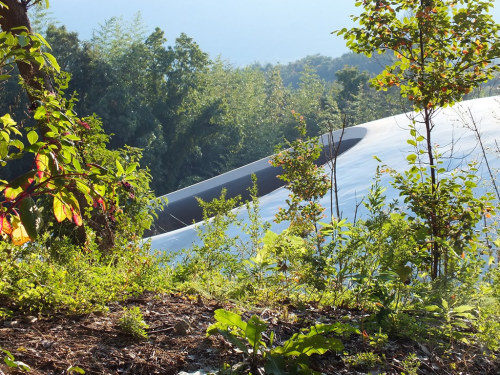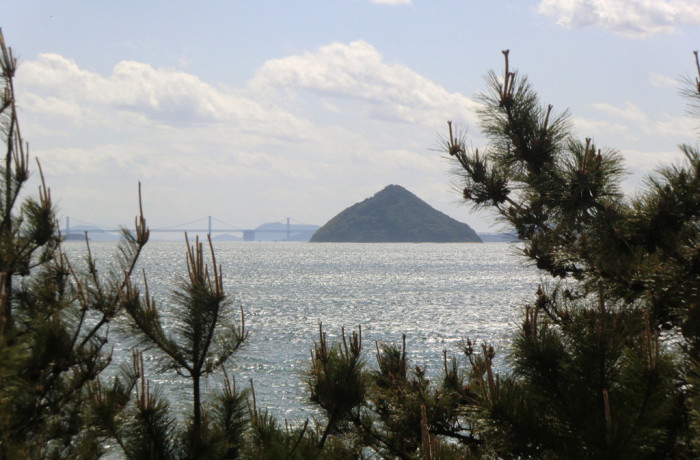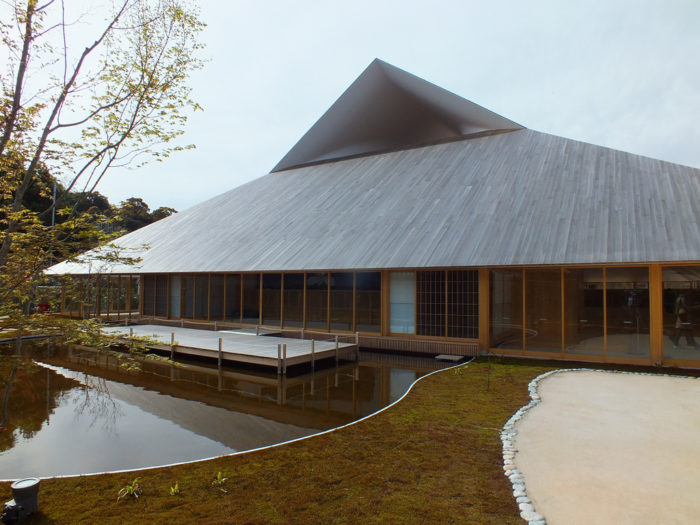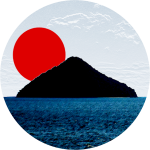Preliminary note: Information for the Setouchi Triennale 2025 is still scarce and incomplete. What you will read on this page mostly comes from the information pertaining to the 2022 edition. So, the information below may or may not be accurate for 2025 (some changes may occur, but they haven’t been decided yet). The page will regularly be updated as new information is made public.
If you plan on coming to the area before 2025, please refer yourself to the information available on the following page: Art Setouchi 2022-2025 Guide.
The Setouchi Triennale is an artistic, architectural, and more generally speaking cultural festival taking place every three years in the eastern part of the Seto Inland Sea of Japan. It’s a must-attend event for art lovers and countryside lovers. Over the past decade, it has become the most important art festival in Japan and one of the most important ones in Asia. It goes beyond exhibiting artworks and architecture from many artists from around the world. It also aims at promoting the area that suffers from depopulation. The main goal of the festival is to revitalize the region through several means, art tourism being one of them. The recurrent theme is “restoration of the sea.”
And if you want to know more about it, you’re in the right place.
What is the Setouchi Triennale?
The Setouchi Triennale (瀬戸内国際芸術祭 – Setouchi Kokusai Geijutsu-sai in Japanese, which can be translated as Setouchi International Art Festival – it was the English name of the first edition) is a contemporary art festival. It takes place every three years as the name states.
While we’re talking about terminology, Setouchi is pronounced more or less like [se-toh-oo-chi]. And Triennale is pronounced the Italian way, more or less [tree-eh-na-leh].
It started in 2010, and 2025 is the sixth edition of the festival.
The term art here must be considered in its broader meaning. It includes contemporary art, but it also prominently features other creative fields such as architecture, performing arts, local crafts, local cuisine, traditional culture, and more.
The Setouchi Triennale is the main event of a larger and permanent endeavor called Art Setouchi.
Also, it must not be confused with Benesse Art Site Naoshima. While it is a part of the Setouchi Triennale and of Art Setouchi, it is only a part of the whole thing. In a sense, it’s not even the most important part, just the most famous one.
While the event aims at being international – and the executive committee has made tremendous progress in this domain since the inception of the Setouchi Triennale – if you don’t understand Japanese, it sometimes remains a little difficult to find useful information about it beyond the very basics.
This page will answer some of the questions you may have, helping you to prepare for your trip to the Setouchi Triennale 2025.
This page is here to give you a few general tips, advice, ideas, and suggestions to help you prepare for your trip to the Setouchi Triennale 2025.
First of all, if you have a question or concern and you don’t find the answer here, or on the rest of the site, feel free to ask me. I’ll reply to you as long as I know it and the answer is not already on this site.
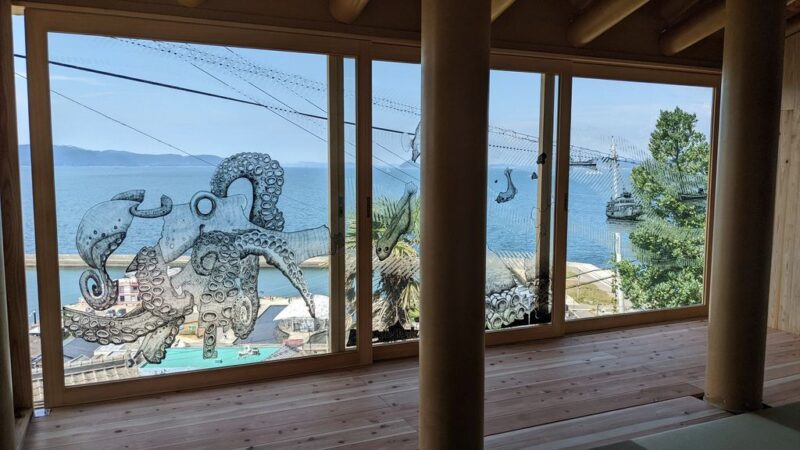
Why is there even a Setouchi Triennale in the first place?
The Setouchi Triennale is not just an art festival. The purpose of such an event taking place on those somewhat remote islands is to revitalize the whole area. One that is rich in culture and history but that is currently threatened by depopulation at a greater rate than most parts of Japan. The goal is to revive the islands and the area through art and culture.
Fram Kitagawa, one of Japan’s most prominent art directors started a similar project in Niigata Prefecture with great success in 2000. After meeting with Soichiro Fukutake, Benesse Art Site Naoshima’s founder, they decided to start a similar project on the islands of the Kagawa Prefecture in the Seto Inland Sea. The success of the first edition in 2010 surpassed all expectations, and it kept on growing with every edition. Nowadays, the Setouchi Triennale has become the largest art festival in Japan and has been gaining notoriety all over the world.
Thanks to its success, newcomers have settled on the islands and have helped revitalize their communities. Even though the battle against depopulation is ongoing, things have been looking up in recent years for the first time in decades.
When is the Setouchi Triennale taking place?
The festival is divided into three sessions following the seasons of the year (except winter, because who wants to be cold when visiting art?)
The dates for 2025 are:
- Spring: April 18 – May 25
- Summer: August 1 – August 31
- Fall: October 3 – November 9
Where is the Setouchi Triennale?
It is located in the eastern part of the Seto Inland Sea of Japan, more precisely at the following locations in the Kagawa Prefecture (or Okayama for two locations).
Seven islands host the Setouchi Triennale during the three seasonal sessions:
| Naoshima | Teshima |
| Ogijima | Shodoshima |
| Megijima | Inujima |
| Oshima |
Two ports have art installations during the three seasonal sessions of the Setouchi Triennale:
| Takamatsu Port (some art may be found in other parts of the city) | Uno Port (As well as train stations between Kojima and Uno) |
Five more islands and three coastal towns also take part in the Setouchi Triennale 2025, but only for one season. Note that the coastal towns are new venues for the 2025 edition.
| Spring only | Autumn only |
|---|---|
| Shamijima | Honjima |
| Summer only | Takamijima |
| Sanuki City | Awashima |
| Higashikagawa City | Ibukijima |
| Utazu Town |
What is there to see during the Setouchi Triennale?
A lot of art, architecture, and more on all of the sites.
For more details, please, check my art guides:
(note that this part of the site is being remodeled, some parts maybe out of date, sorry about this)
How to go to the Setouchi Triennale?
Obviously, it depends on where you’re leaving from.
If you’re already in Japan
The easiest way is most likely by train. You can go to Okayama City by Shinkansen and from there take another train to Takamatsu or Uno Port in Tamano City, as they are the two main access points to the islands.
Note that from Takamatsu you have direct access to any of the islands located east of the Great Seto Bridge except Inujima.
You may need to take a train to access the islands on the western side of Kagawa.
From Uno Port, you can only access Naoshima, Teshima, or Shodoshima.
For access to Inujima, you can take the ferry on Teshima, Shodoshima (the latter only during the Triennale), or from the port of Hoden in Okayama Prefecture.
You can also access Shodoshima by direct ferry from Kobe or Himeji in addition to Okayama and Takamatsu.
You can also arrive in Takamatsu by plane. There are direct flights from Narita, Haneda, and Okinawa. From the airport, a shuttle bus will bring you directly to Takamatsu Station which is located within walking distance of the port.
If you’re coming from abroad
Know that Takamatsu has an international airport with flights to and from Hong Kong, Taipei, Seoul, and Shanghai. In other terms, while it may not matter much if you’re flying from the American continent, if you’re coming from somewhere else it may be more convenient to connect from one of those three places, you will avoid having to make a detour to Haneda or Narita. It’s much faster and cheaper than flying to Tokyo and then back to Takamatsu (or taking the train from Tokyo).
Where to stay during your time in the Setouchi area?
You may be imagining yourself staying in a small minshuku (Japanese bed & breakfast) on one of the islands and hopping to the other islands for day trips and then returning to your minshuku at night. While it would be the perfect way to discover the area, it’s sadly one that is not too realistic. One issue is that the islands have very few ferry routes between each other. New ferries and routes are added during the festival, but overall, it’s just not a practical way to experience the Triennale.
A better and easier option is to stay in Takamatsu. It is pretty much the “center” of the Setouchi Triennale and its main hub. Especially because it’s the only place that has direct access to almost all art islands (with the exception of Inujima). It’s also the place that has the most lodging options, restaurants, and more.
With that being said, if you are very good at planning trips, and are fluent in Japanese, an interesting option is to sleep on a different island every night; spend the day on one island, sleeping there, moving on to the next island in the morning, sleeping there and so on. It’ll be hard work planning it beforehand, as you’ll have to find and make as many reservations as islands you want to visit, but it will be worth it. It would also allow you to discover the islands by night. However, don’t expect exciting nightlife, the islands pretty much shut down at sunset. However, sunrises and sunsets on the islands are hard to beat.
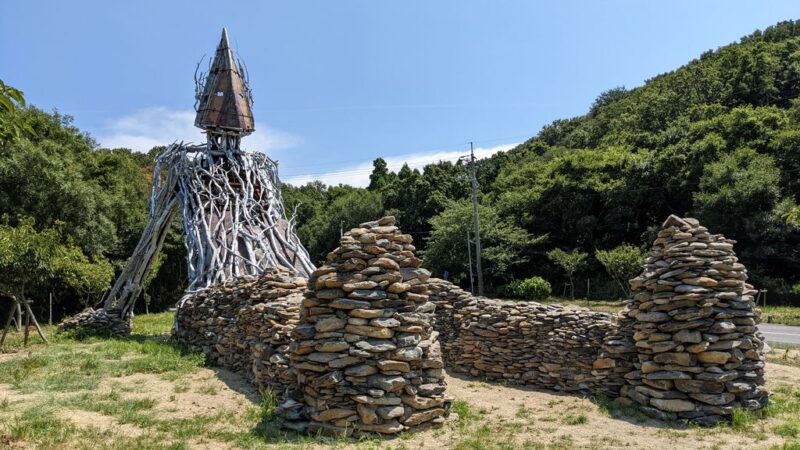
Should I get a “Setouchi Triennale Passport”?
It all depends on how long you’re going to stay and, more importantly, how many artworks you’re planning on visiting. Here is some information to help you decide.
Price
There are two types of Setouchi Triennale Art Passport. One that is valid for the entire festival and seasonal ones that are only valid for one season.
The Three-Season Passport, valid from the entire Setouchi Triennale costs 5,000 yen for adults.
However, it only costs 4,000 yen if you buy it in advance, before the beginning of the festival.
There is a Passport for teenagers between 16 and 18. It costs 3,100.
Access to artwork is free for children and teenagers 15 years old or less.
The Single-Season Passports are valid for only one season (Spring, Summer, or Autumn).
They cost 4,200 yen (2,600 for ages 16-18, free for 15 years old or younger).
You can access all artworks without a Setouchi Triennale Passport, but there is a fee to access a lot of them.
- Access to individual artworks (installed in formerly abandoned houses for example) usually costs 300 yen, sometimes 500 yen.
- Access to museums usually costs between 1,000 and 2,000 yen (a passport will allow you to enter some at a reduced fee, however, please note that the Setouchi Triennale Passport doesn’t include the Chichu Art Museum on Naoshima nor the Teshima Art Museum).
- Outdoor and public art is free.
So no need to start counting artworks one by one to get an idea of the overall cost; unless you’re only spending one day on a smaller island and/or visiting only a couple of things, buying a Passport will always be a good idea (visiting all or most of the art on a big island alone may end up costing more than the price of the Passport).
Paper Passport or Digital Passport
This year the Setouchi Triennale Passport comes in two forms.
The usual paper passport is available as well as a digital passport that can be bought online from the official application, available on both the Android Play Store and the Apple App Store.
There is no drastic difference between the two.
A paper passport will be a nice souvenir when you return home from the Setouchi Triennale, but of course, it can be lost or damaged (it can’t be replaced if that’s the case).
A digital passport is somewhat more convenient but relies on your phone. If you don’t live in Japan, you need to be sure to be able to use your phone in the country as well as pay online with it.
Does the passport offer more advantages?
Yes, it does. Both passports (paper or digital) also give the following advantages and discounts:
- Paid Setouchi Triennale event tickets can be bought at a discounted price.
- You can get a discount at the official Setouchi Triennale shop.
- Free access to the parking lots.
- Discounted prices in Kagawa and Okayama prefectures to various cultural and touristic facilities.
Make sure to double-check the modalities of each of those advantages on the passport itself. Some can only be used a couple of times (especially the discounts in the shop and the access to the free parking lots).
Should I get a Three-Day Ferry Pass?
The Three-Day Ferry Pass is valid for three consecutive days. The price for 2025 hasn’t been made public yet. I will update this paragraph with the new information as soon as I know it. (expect something between 2,000 and 3,000 yen)
The Ferry pass allows access to a certain number of ferries linked to the Setouchi Triennale.
The fare is the usual one-way trip fare for these rides – prices may not be up-to-date, so make sure you double-check on-site. Fares for children (age 6-12) are usually around half-price
- Takamatsu – Naoshima (Miyanoura): 520 yen.
- Uno Port – Naoshima (Miyanoura): 300 yen.
- Uno Port – Teshima (Ieura): 780 yen.
- Uno Port – Teshima (Karato): 1050 yen.
- Uno Port – Shodoshima (Tonosho): 1260 yen.
- Takamatsu – Megijima: 370 yen.
- Takamatsu – Ogijima: 510 yen.
- Megijima – Ogijima: 240 yen.
- Takamatsu – Shodoshima (Tonosho): 700 yen.
- Takamatsu – Shodoshima (Ikeda): 700 yen.
As you can see, it may or may not be useful depending on your plans. I’ll let you do the math.
Keep in mind that there are other routes linking islands to each other or to the main ports that are not included in the Three-Day Ferry Pass. Please, see the next sections.
Taking the ferry to the islands
Taking the ferry to the islands is quite easy and self-explanatory. Shortly before riding the ferry (at least 30 minutes earlier on busy days or if you don’t have a return ticket) go to the port and buy your ticket at the ticket counter. Note that in Takamatsu ticket counters are located in different buildings – close to each other – depending on the ferry you want to ride. Make sure to look at the signs to avoid going to the wrong building. During the Triennale, volunteers are numerous near each ticket counter and will help you if necessary.
There are two kinds of ferries; regular ferries that can carry both passengers and vehicles and fast ferries that can only carry passengers. The latter ones are obviously faster but more expensive (around double the amount of regular ferries). Please note that ticket counters are linked to the kind of ferry you’ll take, not necessarily the island you want to reach. In other words, in Takamatsu, the ticket counters for the regular ferries to Naoshima and Shodoshima are together, but they’re in a different building from the ticket counters to these two islands if you want to take a fast passenger boat.
You cannot make reservations. You must buy your ticket shortly before boarding.
For most routes, you can buy either a one-way or a round-trip ticket. However, a few routes only let you buy one-way trips.
There are no assigned seats on any of the ferries. Most, if not all, ferries have reserved seats for people with disabilities, older people, and pregnant women.
When boarding a ferry, just give your ticket to the attendant at the entrance of the ferry. There is one exception. As it’s the same ferry that brings you to both Megijima and Ogijima, you only need to give your tickets when disembarking at the island of your choice.
Note that some special routes only run a few times a day, always make sure to check the schedules before planning your trips. You’ll understand that I can’t post the schedules here. First, this page is big enough as it is, and also they’re subject to change and I can’t keep track of all of them.
Bringing a car or a bicycle to the islands?
Maybe you live in Japan, maybe you’ve rented a car to visit the country. Now, you’re wondering whether bringing your car or your bike to the islands is a good idea or not.
I’m tempted to answer “no” right away, but it’s a bit more complex depending on your destination.
First of all, be aware that under the term “ferry” you will take many different types of boats. Some can carry vehicles, some can’t.
From Takamatsu, you can load your vehicle on ferries to Naoshima, Megijima, Ogijima, and Shodoshima only.
From Uno, you can bring your vehicle to Naoshima, Teshima, and Shodoshima.
The exact fare for each trip will depend on various factors, but they tend to be quite pricey (expect around 10,000 yen for a one-way trip).
However, in my opinion, it’s a terrible idea to bring your car to Naoshima, Megijima, or Ogijima.
On Ogijima, it’ll simply be useless, you’d have to leave it at the port.
On Megijima it will only be useful to go to the Oni cave, but you can also go there by a small bus trip or even by foot if you don’t mind walking uphill.
On Naoshima, while a car can be useful for going to and from various locations, parking lots are few and rare, especially in the villages. Also, you won’t be able to bring it to the southern part of the islands where most museums are located, unless you’re a guest at the Benesse House Hotel.
Concerning bicycles, they’re also pretty much useless on Ogijima (except in order to go to the lighthouse), not that useful on Megijima (don’t get me wrong, they can be very useful on Megijima, but here I’m talking in terms of visiting the art sites for the Setouchi Triennale). On Naoshima, a bicycle may be the best way to go and visit the island (it’s a bit too big to be walked, and buses have a tendency to be overcrowded during the festival). Keep in mind that some parts will be very hilly, an electric bicycle is more than advised, and some can be rented on the island.
What about Teshima and Shodoshima?
Shodoshima is a large island, much larger than the other ones and if you have the opportunity to bring a car to Shodoshima, please do so, especially if you’re staying longer than one day there. As far as bicycles are concerned, unless you’re an excellent cyclist, I wouldn’t advise it, as large parts of the islands have steep slopes.
On Teshima, a car may be quite useful. However, unless you’re short on time, Teshima is an island that is best experienced as slowly as possible. You’d miss interesting seemingly random spots here and there if you go around by car. On the other hand, a car will allow you to see all of the art on Teshima in one day without having to rush. You can rent some of the islands as bringing one can be difficult (and impossible directly from Takamatsu.)
As far as bicycles are concerned, while the island’s size is perfect, it also has some steep slopes here and there. Know that you can rent electric bicycles, and they really are the best vehicles to visit Teshima. Just be aware that they go fast and bike rentals are usually sold out after the first or second ferry. It is totally possible to make reservations.
What about the other islands?
Inujima and Oshima are to be visited on foot.
Shamijima can be visited on foot, however, as the island is “attached” to Shikoku, you will drive there, or take a bus, not a ferry.
On Honjima, a car can be useful, although I’d advise a bicycle if possible. There’s also a bus service.
On Takamijima, Awashima, and Ibukijima, walking really is the best way to visit the islands (a bicycle too for Awashima only).
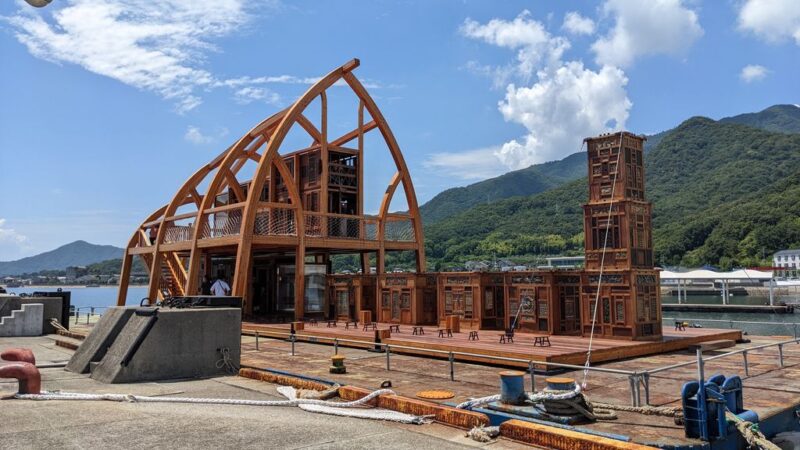
How much time does it take to visit each island?
You will read here and there that one day is necessary for big islands and only half a day or less for smaller islands. I completely disagree with those statements. If you only visit the art sites – quickly – and don’t care at all about enjoying the islands themselves – which would be silly – and are very lucky with waiting lines, then maybe, just maybe, those time frames are realistic. Otherwise, they’re not. We live in a time when we always rush. We live in a society where we always try to maximize everything we do in order to do as much as possible in as little time as possible. Well, if you need to remember only one piece of advice from this page is to leave this way of thinking at home and not bring it to the islands.
On the Setouchi islands, there is an expression common to all of them; “Shima jikan“ (island time). Time just doesn’t work the same way on the islands. The only time that matters is the hour of the last ferry back to where you’re staying (and sometimes the time of your reservation to some art sites). Apart from that, just enjoy where you are at the moment you are there. You’ll thank me later.
Honestly, I fully understand that you probably don’t have an infinite amount of time to visit the Setouchi Triennale, but you will have a much better experience visiting fewer islands and taking your time experiencing them rather than flying from art site to art site, trying to check them all off your list. “Maximizing your time” is the wrong way to approach the Setouchi Triennale.
Here are the various amounts of time for each island that I advise if you plan on seeing all the art sites on each island as well as experiencing the island itself at least a little. If you don’t have all that time – and you probably don’t – just visit fewer places instead of going faster. You’ll thank me later.
- Naoshima: One and a half days to two days.
- Teshima: It is possible to visit it in one day, but a little more would be better, maybe one and a half days.
- Inujima: A few hours are enough. Note that the scarcity of boats to and from Inujima may make it difficult to find a boat at the right time and won’t let you much wiggle room.
- Ogijima: While half a day is enough to see all of the art, it’d really be a shame to not enjoy all the other things the island has to offer. It really is one of the most beautiful small islands of the Seto Inland Sea.
- Megijima: Half a day is more than enough.
- Oshima: Between a couple of hours and half a day, depending on the art that will be shown there.
- Shodoshima: If you don’t have a car, you may need more than three days to see all of the art and you will not have seen much more than just the art. The island is large and art sites are quite spread out. With a car, visiting most of the art sites may take one full day. You also need time to enjoy the island itself, so two days at least.
In the spring only:
- Shamijima: A few hours are enough.
In autumn only:
- Honjima: You’ll need about one day without rushing.
- Takamijima: Half a day.
- Awashima: Half a day to one full day.
- Ibukijima: You may not need a full day to visit it, but it’s quite far from the other islands. There aren’t that many boats, so you may want to be able to take your time and see what the island has to offer and spend the whole day there.
So to visit the seven main islands you will need around six to nine days (with more time needed for the western islands if you visit in the spring or the fall).
Once again, take your time! Way too often, I heard people only saying that they had a great time, but couldn’t remember for the life of them what happened on what island, it was just one big blurry memory a few weeks later. Do you really want your memory of the festival to be that?
Are there guided tours?
The Setouchi Triennale executive committee should provide official guided tours.
Details are scarce at the moment. I’ll update this section when I know more about them.
In 2022, four kinds of guided tours were available:
Basic tours
These tours are group tours. A guide will show you around a given island and introduce its art. These tours will focus on new art.
Special tours
These tours were a new offering in 2022. They focused on a given theme (environment, food, local culture, etc.)
Customized tours
They are designed in collaboration with the visitors prior to their visit.
Study Tours
These may not concern you much as they are various tailor-made tours for schools and companies focusing on different aspects of the Setouchi islands and the festival (culture, history, revitalization projects, etc.)
Anything else to be aware of?
Yes, many, but this page is getting a bit long already. However, one thing I want to emphasize is to keep in mind the reason why this art festival exists. Sure your enjoyment is important, but the goal of the festival is first and foremost to revitalize the islands.
Do not forget that these islands are not giant amusement parks, but places where people live. Most of them are elderly. The islands have their own specificities and their own ways of doing things. Partly because of the culture of each one of them, partly because of the geography of what it is to be on a small island.
Yes, some things will be inconvenient, but that’s the way it is. Those islands were not created for the Triennale and for their visitors. Once again, they’re not an amusement park.
When you’re on the islands, it’s very important to respect the rules and the locals. That is among other things:
- Be polite and considerate to the locals, don’t ignore them; a smile, a nod, or a Konnichiwa will be greatly appreciated.
- Respect private properties, do not enter people’s houses or courtyards. It sounds obvious, but believe me, it’s not for some visitors.
- DO NOT LITTER! Keep your trash with you. This is the Japanese way of doing things (trash cans will be waiting for you when you’re back in Takamatsu Port).
First, littering is wrong – anywhere in the world – but more importantly, the islands cannot sustain the visitors’ trash. The quantity of trash that a given island can handle is the quantity generated by the locals and nothing more. This is a very important point that many urban visitors have trouble understanding because it’s usually not something they need to think about in their everyday lives. It is a thing you need to think about on the islands. - Public restrooms are rare (but usually well-indicated and clean most of the time). Keep that in mind when you’re on the islands. Use them when you see them, you never know where and when you’ll encounter the next one.
- Some streets, some buildings, and some areas will be unpractical. The islands were not designed for visitors, and they’re not urban areas.
- If you’re not used to Japan, remember that there are many places in the country where shoes need to be taken off indoors. This is also true for many art sites, cafés, and such. Make sure to wear comfortable shoes that are easily taken off and on. It will make your visits much easier (not just on the islands, but in all of Japan).
- If you visit during summer, don’t forget that summers can be brutally hot in Japan. The islands are no different. Stay hydrated, and wear hats and sunscreen. Heatstrokes among visitors happen too often as too many visitors underestimate the heat. You don’t want that to happen to you.
And that’s a wrap for my Setouchi Triennale advice and tips page. It is updated regularly when more questions or more information arise, and/or if I forgot important points (because I overlooked them as obvious but maybe they’re not for someone who doesn’t know the area).
Enjoy.
A few last words while you’re here.
If you have found this page useful to prepare for your trip to the Setouchi Triennale, there are a few ways that you can thank me and support my work.
FAQ
While it is not solely dedicated to the Setouchi Triennale, this site also has a FAQ that may answer some of your questions:
Credits, Sources & Disclaimers:
- This site is by no means official.
- Opinions expressed on this site are my sole responsibility.
- While I try to keep the information up-to-date and accurate, they are not contractual and may change at any time.
- I do not use second-hand sources (i.e. I don’t copy from other sites). All my sources are either official sources or come from my personal experience and knowledge of the area and of the Setouchi Triennale. Remember that it literally took me years and countless visits to each island to be able to make this page.
If you want to use some of the information provided on this page for your own site, please mention your source with a link to this page. Thank you. - All pictures are mine unless stated otherwise. Be kind to not steal them. However, if you ask to use one or more, I may just say yes (usually with a link to the source).
- The Setouchi Triennale posters and visuals may sometimes be used on the site. However, they belong to the Setouchi Triennale’s Executive Committee.
Thank you.
